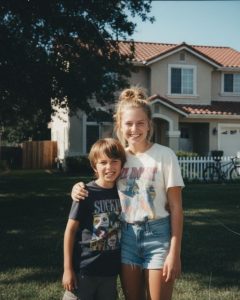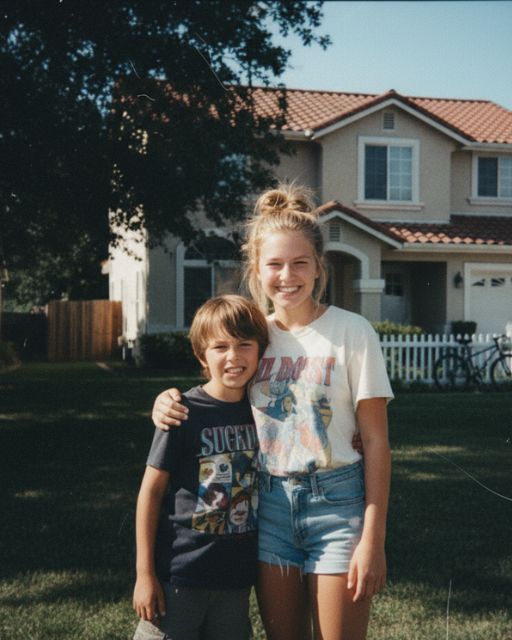He still had sunscreen on his nose and grass stuck to his knees. We had just gotten home after riding our bikes to the end of the block and back. Aunt Marla urged us to stand in front of the house “for memories.”
I didn’t know that this would be the last picture we took together.
Two mornings later, he was gone.
Not just gone, but missing. Gone as if no one is watching.
People say he “ran away.” He stated he was probably upset about school. He said he had been at school for an hour before. But his backpack was still there. His shoes, too. He always wore shoes when he went out.
I asked Aunt Marla if the cops were coming back.
That’s when she said no. They argued they had “more important things” to worry about. They said that a boy like him probably just needed to blow off some steam. But I felt sick to my stomach since I knew him better than anyone else. He wasn’t the type of person who would just go.
I kept staring at that photo. It appeared like he wanted to say something but couldn’t since his smile looked false and his hand was half-open at his side. It began to look like a clue.

The neighbors whispered about it. Some people said they spotted him talking to a man in a pickup truck the night before. People reported they heard yelling in the back yard. But no one wrote anything down or sought for replies. After the first week, people stopped talking about him, and the rumors died down.
Not me.
I couldn’t.
I started riding my bike by myself. Every morning, one of them still leaned against the garage door, like if it were waiting for him. The chain made a noise, and the seat was too low for me, but I still got on. It made me believe he was still there.
A month later, one afternoon, I was biking around the neighborhood when I spotted something strange. There was a piece of red cloth stuck high up on a tree at the border of the woods behind our street. It didn’t belong. Too bright and too planned.
I threw the bike away and rushed up, branches slashing my arms. When I arrived there, I felt terrible. It wasn’t just a piece of cloth. In the picture, he was wearing a shirt with a sleeve. The blue lines were still there, but the dirt made them hard to see.
I paused.
It didn’t make any sense. If he had “run away,” why was his clothing here?
I put it in my bag and rode home, but my hands were shaking so terribly that I almost crashed.
That night, I showed it to Aunt Marla.
She became white. Then she took it from me and threw it away. He stated it was “just an old rag.” He told me that I was letting my thoughts get the best of me.
But I could tell that her hands were shaking. She cautiously looked toward the back door.
At that point, I started to think that the grown-ups might know more than they were letting on.
I didn’t tell anyone else. Not yet. Instead, I started to write things down. I wrote down every story I heard and every unusual thing I witnessed in a notebook that I kept under my bed. Dates, times, and other information. I was just thirteen, but I felt like I had to be the detective that no one else wanted to be.
Weeks passed. While I was cleaning the garage one morning, I found a shoebox full of Polaroids under a pile of paint cans. Most of them were just normal pictures of family get-togethers, birthdays, and trips to the lake. But there was one near the bottom that made me stop.
It was him. My cousin. He was next to the pickup truck that the neighbors had talked about.
The man in the picture put his arm over him too tightly, like he was holding him instead of hugging him. My cousin’s face didn’t look happy; it looked anxious.
I gave Aunt Marla the picture.
She lost it. Told me to stop gazing around. Told me I was just making things harder for everyone. But I saw her use the back of her sleeve to wipe her eyes when she turned away.
That night, I couldn’t sleep. I couldn’t quit thinking about the truck. I hadn’t seen a picture like that in weeks, but it was still quite clear in my mind. So I made a plan.
After school, I rode my bike around town every day. I drove past parking lots, passed the gas station, and even stopped by the old diner. And then I watched it on a Friday.
The same truck. The same fender with a dent. The paint is still coming off.
The hardware store had it parked in the rear.
My chest felt tight.
I quickly drove home and scrawled the license plate number on my hand with a marker.
I thought Aunt Marla would finally feel better after I showed it to her. She thought I would phone the police to tell them I had uncovered something important. Mom didn’t do that, though. Instead, she sat me down at the kitchen table and said, “You can’t tell anyone about this.”
I didn’t understand. Why not?
At that point, she finally spoke the truth.
She knew the man.
He was her boyfriend a long time ago. This was before she moved back in with us. He wasn’t supposed to be there anymore, but he would still come.
My cousin didn’t like him. He stated it made him feel weird.
And then she said something that made me tremble.
The night before he went missing, she heard them arguing in the yard. She thought it was just another fight, so she went back to sleep. He was gone by dawn.
She didn’t call the cops again because she was too terrified. She was afraid they would blame her. She was scared they would think she let it happen.
I sat there and looked at her, and my chest hurt. She had always known some of the truth.
But she hadn’t done anything.
I wanted to scream, but instead I took the notepad out from under my mattress and flung it on the table. I told her that I would fight for him if she didn’t.
The next day, I went to the police on my own.
At first, they didn’t believe me. They told me I was “just a kid with crazy stories.” But when I showed them the picture of the man with my cousin and the car’s license plate number, things changed.
They told me to wait outside while they made some phone calls.
Someone knocked on our door two weeks later.
They had found the truck.
They located it empty in a country three hours distant, close to a row of storage buildings. They found more Polaroids in one of the apartments. Kids from all across town. Kids who had all run away.
They did find my cousin’s clothing, though, buried behind a lot of old trash and blankets.
He wasn’t there. But it was proof. Proof that he didn’t just “leave.” It showed that someone had taken him.
The police started a bigger search. This time, they didn’t stop after a week. Flyers went up again. The dogs looked in the woods. There were news teams. People who had been mumbling and turning away were suddenly in queue to help.
And for the first time since that image, I thought that maybe—just maybe—someone was truly paying attention.
A few months passed. It was like walking through fog every day. School didn’t matter. Friends weren’t important. I couldn’t stop wondering if he was still out there. I thought he could be waiting for me to keep looking.
Then, one night about a year later, the phone rang.
They had found him.
Still living.
They had kept him in a cottage three towns away. Someone saw him on the flyers and phoned the cops. When the police came to check the place, they discovered him locked up in a back room.
He appeared older and thinner, like he had aged twice as fast in a year. But when he came out and saw me, he smiled with the same crooked smile that was in the image.
We didn’t say anything at first. We just hugged.
It didn’t change what happened. It didn’t stop the months of being still or the nights of worry. But that was all. I was sure I hadn’t made a mistake. Enough to know that it was worth it to fight for him.
They arrested the man. He won’t hurt another child ever again. Aunt Marla cried and said how sad she was. I told her she should have said anything sooner. She stated her fear almost cost her everything.
Things didn’t go back to how they used to be. Not really. But in some ways, it got better.
We realized that it’s better to talk about things than to keep them to ourselves. We figured out that being quiet could be just as dangerous as the animals outside. We learnt that one person who won’t give up can change everything, even when everyone else is looking away.
I still look at the last image we took together from time to time. It seemed like it was done. Now it seems like a reminder.
A reminder that people aren’t really gone until you stop fighting for them.
And maybe that’s what I want everyone to take away from this. Don’t ignore what doesn’t feel right. Don’t be shy about speaking up. A single, steady voice can sometimes turn a lost person into a found one.
Please share this if you’ve read this far. It might help someone else remember to keep looking, asking, and having faith. If you enjoyed it, that indicates it meant something to you.
